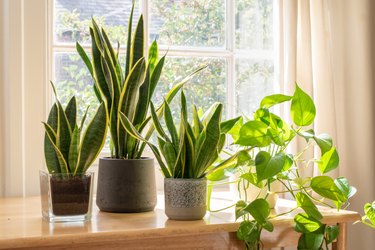
You've been diligent about feeding your houseplants the right fertilizer, maintaining a watering and spraying routine and placing them where they can get the sun they need. However, they have developed water spots on the plant leaves, diminishing their appearance. The water spots, for the most part, do not indicate an infestation of predators but rather a reaction to the water sprayed on them and in the soil. Returning your plants' leaves to the shiny luster they had when you purchased them isn't difficult, requiring the use of just two household ingredients and an adjustment your watering and misting routines.
Identifying Hard Water Spots on Plants
Video of the Day
Water spots on your plant leaves is an indication that the water in your home is "hard water." The differences between hard and soft water are due to the amount of minerals and chemicals in the water. Higher levels of lime, salts, calcium and magnesium make water hard, while sodium makes the water soft. Your water spots are merely deposits of those chemicals on the leaves.
Video of the Day
Visually, there is no difference between hard and soft water. However, you can determine which type of water you have by examining glasses pulled from the dishwasher if you don't use an added water softener to the machine. Water spots occur due to deposits of calcium carbonate. A film left on your skin after washing is another indication of hard water. And, the water spots on your plant leaves is an immediate "tell" for identifying the type of water you have.
Combatting Water Spots on Leaves
There are two simple remedies for removing water spots and one remedy for preventing them. If the leaves are sturdy, a little juice from a slice of lemon, wiped over and under the leaf should remove the spots. If the leaves are delicate, wet a fresh sponge with lemon juice and rub it along the fronds, using your hands underneath the leaf to provide support. Rinse the leaf with purified water which doesn't have the minerals in its composition.
Alternatively, combine a tablespoon of vinegar with a quart of either purified water or rainwater. Dip a soft cloth into the water solution and gently wipe the affected leaves until the spots are gone. Not only does this remedy remove water spots, it repels pests and pets. It also leaves the immediate area smelling clean and fresh. To prevent further buildup of deposits, water the soil and spray the leaves with purified water.
What Not to Do to Remove Water Spots
Commercial leaf shine products work against your plant by clogging the leaves' pores with additional chemicals. The plant breathes through it leaves, so you want to prevent it from suffocating. The cleaning wipes you have most likely contain alcohol. Do not use them to clean the leaves. Lens cleaner and glass cleaner will do more damage to the plant leaves than the hard water spots.
Investing in a water-softening system isn't the answer, either. It merely takes away the chemicals from hard water and replaces them with salt. Neither are beneficial to houseplants. If you are unable to collect rainwater, use bottled, purified water when caring for your plants. This may mean a total replacement of the plant's soil and starting fresh, but your plant will be better off without the chemicals from hard water running through its system.